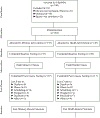Senior WISE intervention: Gender differences in bodily pain and trait anxiety
- PMID: 34176575
- PMCID: PMC8239252
- DOI: 10.1016/j.apnu.2021.05.001
Senior WISE intervention: Gender differences in bodily pain and trait anxiety
Abstract
Purpose: In this secondary analysis we tested whether 12 h of Senior WISE (Wisdom Is Simply Exploration) memory or health training with older adults would produce better outcomes by gender in perceptions of anxiety and bodily pain and whether the effects of the Senior WISE training on pain were mediated by anxiety.
Design: An implemented Phase III randomized clinical trial with follow up for 24 months in Central Texas. The sample was mostly female (79%), 71% Caucasian, 17% Hispanic, and 12% African American with an average age of 75 and 13 years of education.
Results: The effects of the memory intervention on anxiety were consistent across time, with effects present for males but not females at post-treatment and end-of-study. Although males had more anxiety in the health promotion group, the memory training reduced males' anxiety such that no gender difference was present in this group. The Senior WISE intervention reduced pain for both males and females at post-intervention but not at end-of-study. Although gender differences did not depend on the treatment group for pain, females reported somewhat, but not significantly, less pain at post-treatment and end-of-study. Mediation analysis indicated that, for males, the memory intervention indirectly affected pain at post-treatment, in part, by reducing anxiety, which lowered pain. However, at end-of-study, no indirect effect was present. Males responded to memory training. Training tailored to gender may increase the efficacy of the programs and "buy-in" from male participants, especially if tailored to anxiety and pain.
Keywords: Bodily pain; Gender differences; Memory training; Psychosocial intervention; Trait anxiety.
Copyright © 2021 Elsevier Inc. All rights reserved.
Figures
Similar articles
-
The influence of androstadienone during psychosocial stress is modulated by gender, trait anxiety and subjective stress: An fMRI study.Psychoneuroendocrinology. 2016 Jun;68:126-39. doi: 10.1016/j.psyneuen.2016.02.026. Epub 2016 Feb 27. Psychoneuroendocrinology. 2016. PMID: 26970712 Clinical Trial.
-
Behavioural modification interventions for medically unexplained symptoms in primary care: systematic reviews and economic evaluation.Health Technol Assess. 2020 Sep;24(46):1-490. doi: 10.3310/hta24460. Health Technol Assess. 2020. PMID: 32975190 Free PMC article.
-
Alleviated Anxiety Boosts Memory Training Gain in Older Adults with Subjective Memory Complaints: A Randomized Controlled Trial.Am J Geriatr Psychiatry. 2022 Feb;30(2):184-194. doi: 10.1016/j.jagp.2021.05.006. Epub 2021 May 19. Am J Geriatr Psychiatry. 2022. PMID: 34162512 Clinical Trial.
-
SuRxgWell: study protocol for a randomized controlled trial of telemedicine-based digital cognitive behavioral intervention for high anxiety and depression among patients undergoing elective hip and knee arthroplasty surgery.Trials. 2023 Nov 9;24(1):715. doi: 10.1186/s13063-023-07634-0. Trials. 2023. PMID: 37946291 Free PMC article.
-
Psychological interventions for improving adherence to inhaled therapies in people with cystic fibrosis.Cochrane Database Syst Rev. 2023 Mar 29;3(3):CD013766. doi: 10.1002/14651858.CD013766.pub2. Cochrane Database Syst Rev. 2023. PMID: 36989170 Free PMC article. Review.
References
-
- Anderson AR, Deng J, Anthony RS, Atalla SA, & Monroe TB (2017). Using complementary and alternative medicine to treat pain and agitation in dementia: A review of randomized controlled trials from long-term care with potential use in critical care. Critical Care Nursing Clinics North America, 29(4), 519–537. - PMC - PubMed
-
- Austin EJ, Gibson GJ, Deary IJ, McGregor MJ, & Dent JB (1998). Individual response spread in self-report scales: personality correlations and consequences. Personality and Individual Differences, 24, 421–438.
-
- Baltes PB, & Danish SJ (1980). Intervention in life-span development and aging. In Turner RR, & Reese HW (Eds.), Life-span developmental psychology (pp. 49–78). New York: Academic Press.
-
- Bandura A (2012). On the functional properties of perceived self-efficacy revisited. Journal of Management, 38(1), 9–44. DOI: 10.1177/0149206311410606 - DOI





